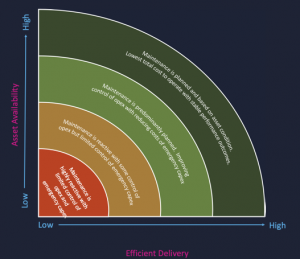Prove the worth of your maintenance team
In these uniquely challenging times, the demand for effective maintenance teams in our organisations has never been greater. We face complex and interconnected problems that can only be solved by maintenance teams who see the bigger picture and adapt to an ever-changing context.
Managing a maintenance function in a utility business has always been challenging. But, unfortunately, it’s about to get much more challenging. The huge capital investments made in the asset base over the last 25 years have tapered down. Yet, the ask for those same assets increases from almost all angles through increased regulatory pressure, population shifts and climate change.
The requirement to balance asset availability within the confines of tight budgets means teams need to make increasingly difficult risk-based decisions every day. It’s left to the maintenance teams to keep the asset going to maintain customer service and regulatory compliance.
If we think about the purpose of maintenance, there are lots of definitions, but there are two aspects which all definition include:
- Availability – is the asset available when required by the customer
- Efficiency – does maintenance support the efficient delivery of service
For us, the primary measure of success is asset availability. High levels of asset availability indicate that the assets are in good condition and available when required by the customer.
Measuring availability can be highly complex, especially where there is redundancy in the systems and complex interactions within assets. In our experience, we have found measuring emergency workload volume and the time to restore these failed assets is a good ‘proxy’ for asset availability. These are jobs where an immediate response is required as there is an actual or significant risk to safety, customers, or the environment.
If only life was as simple as just managing asset availability, teams also need to operate within their budgets. In a world where there is more work than resources, they are unlikely to underspend, so how do you know if you are getting value for money? Now we also need to measure the efficiency of maintenance delivery.
This goes beyond budget and looks at the quality of work completed. We often hear teams talking about jobs per day as a good measure; improving jobs per day makes us more efficient, right?
The problem with jobs per day is that it doesn’t differentiate between good work and bad work; it treats all jobs equally. Our approach does differentiate and provides a meaningful measure of efficiency.
We think about efficiency in two ways:
- Did we complete the maintenance tasks right first time?
- Do the assets experience repeated failures?
In a world where there is more workload than resources focusing attention on efficiency is critical. We know driving improvement in efficiency will release capacity to undertake more (ideally preventative) maintenance work, reducing risk leading to improved availability.
Maintenance diagnostic framework

We have created a maintenance diagnostic that allows maintenance teams to measure the effectiveness of their maintenance, providing insights into crucial leavers to improve availability and efficiency.
If you would like more information about our maintenance diagnostic, please drop us a line at hello@reson8.group




